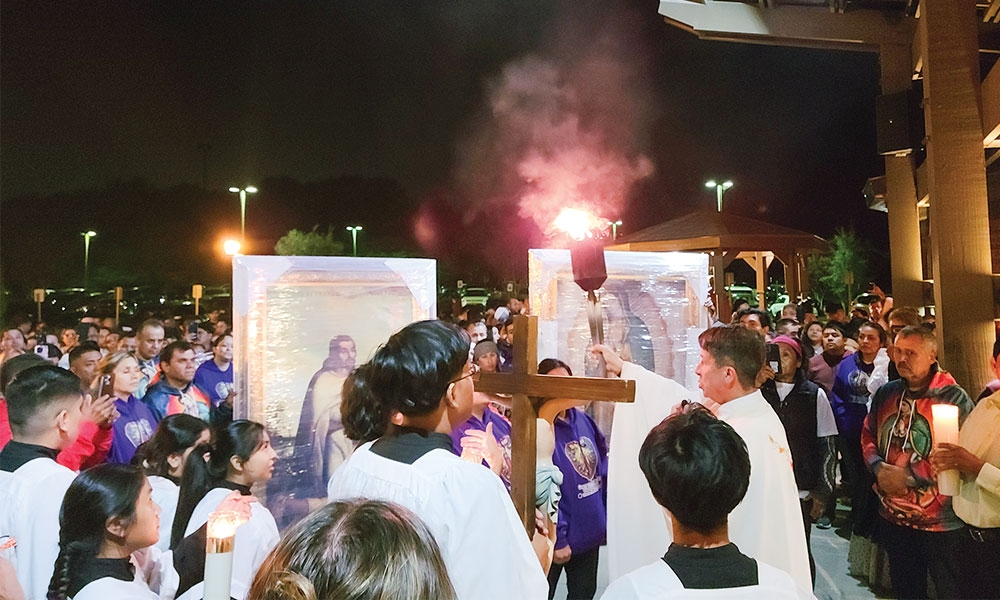
Latin Americans find hope carrying the Guadalupe torch
In the early morning hours on Nov. 5, 2023, 255 runners began a 75-mile relay-style pilgrimage from Toccoa, Georgia, to St. Mary Magdalene Church in Simpsonville. These runners, however, were not seeking fast-paced times, and there were no winners declared at the finish line. Instead of passing a baton, the relay runners passed a torch — the Guadalupana Torch, in fact.
In the early morning hours on Nov. 5, 2023, 255 runners began a 75-mile relay-style pilgrimage from Toccoa, Georgia, to St. Mary Magdalene Church in Simpsonville. These runners, however, were not seeking fast-paced times, and there were no winners declared at the finish line. Instead of passing a baton, the relay runners passed a torch — the Guadalupana Torch, in fact.
A 73-day pilgrimage, Guadalupe Torch Race (Carrera Antorcha Guadalupana), begins each fall in Mexico City at the National Basilica of Our Lady of Guadalupe. The ever-lit torch is carried by thousands of runners up through Mexico then through various churches and sites in the United States, ending at St. Patrick’s Cathedral in New York City. The journey is a message of faith, peace and justice to communities divided by foreign borders.
For communities of Spanish-speaking Catholics in Simpsonville, it was a way to participate in the spiritual aspect of showing their devotion to Mary. They serve as messengers of support for the dignity of immigrants, celebrating and paying homage while trekking with the Guadalupana Torch.
The tradition is most popular among people from Mexico, but Maria Rosario, parishioner of St. Mary Magdalene, explained that it is special to everyone from Latin America.
While running and carrying the torch, an image of the Virgin of Guadalupe follows, helping to inspire participants during sometimes long stints of running.
Rosario’s parents, Francisco Rosario and Juana Alonso, lead the Guadalupano Ministry at St. Mary Magdalene.
Rosario said that registration for the event took place at the church at 7:00 a.m. on Nov. 5. By 8:00 a.m., they had 255 runners registered for the 75-miles distance between the Georgia and South Carolina stops. The torch needed to make it to St. Mary Magdalene for Mass at 7:30 p.m. that evening.
The ministry had 13 vans full of runners who were brought to the start where the torch was passed by a group who had made the journey in Georgia. She said that each pilgrim would run at least 100 meters before passing the torch to the next. Participants rode in the vans when they weren’t running. Not all were fellow parishioners; some runners came from neighboring cities like Greer and Greenville.
“It took them until about 7:00 p.m. to make it back to Simpsonville,” Rosario said.
She noted that the Guadalupano Ministry provided light breakfast, lunch and dinner for the runners. And, after the Mass that evening, the public was given tamales, hot chocolate, pan dulce and juice.
“We decorate the altar for the Mass when the runners arrive, and we light a candle from the torch to have inside the church,” she said.
In the proceeding two days, the torch was taken to San Sebastian Mission in Greenville and then to Blessed Trinity Church in Greer. Then the torch made its way to the border of North Carolina for others to carry it through the state.
As the torch continued onto New York City, it created a symbol of hope for immigrant communities since the devotion to Our Lady of Guadalupe transcends borders. She is, after all, the patroness of all the Americas. This annual event is a symbol of unity between the diverse people that make up the United States and the rich cultures on which the country is founded.
This year, the pilgrim runners began with Mass in Mexico City on Aug. 30. The torch arrives in New York City on Dec. 12, the feast of Our Lady of Guadalupe. Follow its progress at facebook.com/carreragmexny.
